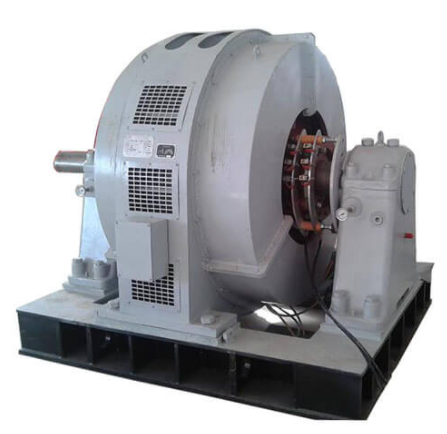Synchronous motors, as the name implies, rotate at a constant (synchronous) speed. The rotor of this type of motor is a wound rotor, which receives its excitation (magnetizing) current from its excitation system (a separate DC power supply with a controller). Compared to induction motors, synchronous motors, although more expensive and requiring more maintenance, are used for applications requiring constant speed (such as in the textile fiber and paper industries), high operating efficiency and controlled power factor. These last two factors are especially important above 1000 kW. Large plants often use synchronous motors to drive central air compressors. A single large synchronous motor can be used to control the plant-wide power factor and compensate for the lagging power factor of a large number of small and medium-sized induction motors.
Synchronous motors are not inherently self-starting on an AC supply with a mains frequency of 50 or 60 Hz. This is because synchronous motors can only produce torque when they are running at synchronous speed.
40p 1600KW High Voltage Permanent Magnet Synchronous Motor
Therefore, we need some way to start a synchronous motor. Once the rotor reaches a speed starting device close to the synchronous speed (>95%) through some time, the excitation winding will be excited and therefore the motor locks into synchronization.
There are some techniques used to start synchronous motors. As a simple method, a separate motor is used to drive the rotor at near synchronous speed. The second method is to start the synchronous motor as an induction motor. In this case, the rotor has a special damping winding for starting, which is similar to the squirrel-cage arrangement of an induction motor. When the synchronous motor is started, the induced current in the damping winding generates torque, so it can be started as an induction motor. In addition, the damping winding has another function to help keep the synchronous motor synchronized. If the motor speed increases or decreases from synchronous speed, a current is induced in the damping winding and a torque is generated to resist the change in speed.
As for the method of starting a permanent magnet synchronous motor used in a variable speed drive, we can use a PWM inverter to slowly start the motor at a reduced frequency. In this case, the information about the initial rotor position can be used to generate a high starting torque.
Synchronous motors have certain advantages in certain applications. They are the obvious choice for driving large, low-speed reciprocating compressors and similar equipment with motor speeds below 600 rpm. They are also useful on many large high-speed drives. Typical applications for this type are geared, high-speed (above 3600 rpm) centrifugal compressor drives of several thousand horsepower.
A rule of thumb used in the past for constant speed applications was to consider selecting synchronous motors with more applied horsepower than speed. Of course, this is only an approximation and the preference is for a synchronous motor. Under current standards, this would be considered too severe. However, the rule can help in selecting a motor type by providing some insight into when a synchronous motor may be selected. For example, applications with a few horsepower per revolution typically offer a clear advantage of synchronous over induction motors. In fact, at the lowest speeds, larger sizes and the highest hp/rpm ratios may be the only options.

Synchronous Motors for Air Separation Applications
An interesting feature of synchronous motors is their ability to provide power factor correction for electrical systems. Standard synchronous motors can provide leading power factors of 100% or 80%. Due to their size, 80% power factor motors cost 15% to 20% more than unit power factor motors, but the difference may be less than the cost of an equivalent set of capacitors. One advantage of using synchronous motors for power factor correction is that the reactive kVA can be varied at will by adjusting the excitation current. in addition, synchronous motors produce more reactive kVA as the voltage drops (for moderate dips) and therefore tend to stabilize system voltages better than capacitors because they provide the greatest amount of overrun kVA when the voltage is at a minimum.
Please contqact ZCL if you have any questions, send us an email to get the quote.
Copyright:@2020-2021
Comments Please sign in or sign up to post.
0
0 of 500 characters used